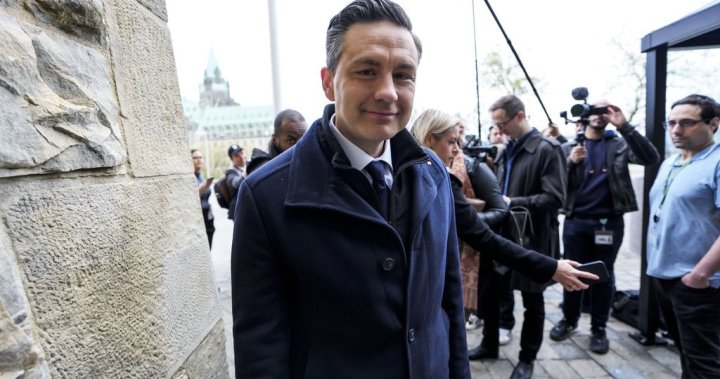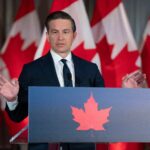In the aftermath of his most recent town hall in Edmonton, Conservative leader Pierre Poilievre has found himself clarifying remarks on Canada’s population growth that sparked debate across political circles.
“What I said is that we need to slow the rate of growth, not that we need to stop immigration,” Poilievre told reporters following the event. The distinction has become increasingly important as his comments have drawn scrutiny from political rivals and immigration advocates alike.
At issue were statements made during the Edmonton gathering where Poilievre suggested Canada’s current population growth rate—running at approximately 3% annually—was straining housing, healthcare, and infrastructure. The Conservative leader has maintained that his position focuses on ensuring sustainable growth rather than implementing restrictive immigration policies.
Liberal Immigration Minister Marc Miller quickly characterized Poilievre’s original comments as “reckless” and potentially harmful to Canada’s economic recovery. “When political leaders make sweeping statements about population without context, it creates unnecessary anxiety,” Miller said during Question Period last week.
According to Statistics Canada, the country added nearly 1.3 million people in 2023, with roughly 95% of that growth coming from immigration. The unprecedented population surge has coincided with a housing crisis that has seen average home prices increase by more than 50% in many urban centers since 2019.
Richard Kurland, a Vancouver-based immigration lawyer and policy analyst, suggests the debate reflects deeper tensions in Canadian society. “What we’re seeing is the collision between Canada’s ambitious immigration targets and the very real infrastructure limitations in our cities,” Kurland told me in a phone interview. “Both sides of this debate have legitimate concerns.”
The Conservative leader has used the opportunity to double down on his “housing hell” messaging—a cornerstone of his political narrative that connects affordability challenges directly to Liberal government policies. “Justin Trudeau has brought in more people than we have homes for,” Poilievre stated during a press conference in Calgary yesterday.
For their part, the Liberals have defended their immigration approach as essential to addressing labor shortages and supporting Canada’s aging population. Deputy Prime Minister Chrystia Freeland pointed to recent adjustments in immigration targets as evidence the government is responding to infrastructure pressures. “We’ve taken a balanced approach that considers both our economic needs and our capacity to welcome newcomers successfully,” Freeland noted at a Toronto economic forum.
What’s often lost in the political crossfire are the nuances of Canada’s demographic challenges. The Conference Board of Canada has projected that without immigration, Canada’s population would begin to decline by 2034, creating potential economic and social service funding gaps as the proportion of working-age Canadians shrinks.
“It’s not a simple equation,” explains Dr. Naomi Alboim, a former provincial deputy minister who now teaches immigration policy at Queen’s University. “Canada needs population growth to maintain economic vitality, but that growth requires coordinated planning across all levels of government.”
The controversy highlights the increasingly central role immigration policy plays in Canadian political discourse. Recent polling from Abacus Data shows approximately 44% of Canadians now believe immigration levels are too high—up from 27% in 2021. This shift in public sentiment has created political space for more critical discussions about population growth management.
In Edmonton’s Riverbend community, where housing developments have struggled to keep pace with the city’s expanding population, the debate feels anything but abstract. “We welcome newcomers, but we also need places for people to live,” said Sunita Gill, president of the local community association. “You can’t separate immigration policy from housing policy—they’re two sides of the same coin.”
For municipal leaders caught between federal immigration targets and local infrastructure realities, the challenges are immediate. Calgary Mayor Jyoti Gondek has recently called for better coordination between immigration levels and funding for urban infrastructure. “Cities are where population growth happens in real time,” Gondek emphasized at last month’s Federation of Canadian Municipalities meeting. “We need resources that match the responsibilities we’re shouldering.”
As the political debate continues, economists point out that population growth itself isn’t necessarily problematic—it’s the pace and preparation that matter. TD Economics recently noted that Canada’s housing starts would need to nearly double to accommodate current growth rates, a construction pace not seen since the post-war building boom.
For voters watching this debate unfold, the central question may be less about population numbers and more about which level of government should coordinate the complex interplay between immigration, housing, and infrastructure development.
Whatever the political outcome, one thing remains clear: Canada’s approach to managing population growth will shape communities across the country for generations to come. And as Pierre Poilievre’s comments demonstrate, finding the right balance between welcoming newcomers and building sustainable communities remains one of the most challenging puzzles in Canadian public policy.






